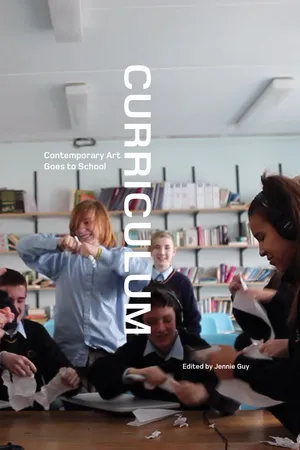
- 200 pages
- English
- ePUB (mobile friendly)
- Available on iOS & Android
About this book
There is an urgent focus on education around the world, and this book is pushing directly into this territory. It will appeal to a wide range of readers – to anyone who is passionate about art and or education – and will have a strong international appeal as the contributors have international profiles and the book is poised to address global issues concerning contemporary art, education, and independent practice.
In this collection of original essays, the writers engage with the work of the artists who took part in Art School. Each contribution provides a lens through which each writer can focus on specific moments within the evolution of Art School, working outwards to explore how these moments resonate with the wider fields of art-in-education and radical pedagogies. These texts respond to a widespread concern with art and its place in education, while retaining a committed and informed engagement with the phenomena they assess.
Art School takes place as a series of independent projects, exhibitions, workshop and residency programmes, bringing active contemporary artists into educational systems to inspire and expand their teachings.
Responding to a growing desire to rethink art education at all levels, it is for those committed to new forms of social imagination and social engagement in contemporary art. This book is for curators, schoolteachers and other educators, and also for artists and art students who wish to extend their practice beyond the gallery.
Less a manifesto or a declaration of doctrine than an emergent set of experiments, Curriculum considers the school as a zone of artistic and curatorial practice, foregrounding the potential of contemporary art (understood in wide terms) to stimulate students' creativity in original and open ways.
Although the book focuses on a specific project in Ireland, that project exemplifies trends in art and education that are happening around the world and includes contributions from an international group of scholars all well-known in their field.
Contributors: Clare Butcher, Gerard Byrne, Juan Canela, Helen Carey, Daniela Cascella, Fiona Gannon, Jennie Guy, Andrew Hunt, Hannah Jickling & Helen Reed, Alissa Kleist, Rowan Lear, Peter Maybury, Annemarie Ní Churreáin, Nathan O'Donnell, Sofia Olascoaga and Priscila Fernandes, Matt Packer and Sjoerd Westbroek.
Artists: Sven Anderson, John Beattie, Clare Breen, Sarah Browne, Karl Burke, Rhona Byrne, Ella de Búrca, Vanessa Donoso Lopez, Priscila Fernandes, Hannah Fitz, Jane Fogarty, Kevin Gaffney, Adam Gibney, Fiona Hallinan, Elaine Leader, Maria McKinney, Maeve Mulrennan, Mark O'Kelly, Sarah Pierce, Naomi Sex and Orlaith Treacy.
Primary interest will be among educators, artists, curators, academics and students, and others working or studying in a variety of settings including school, universities, museums, and other arts organisations.
Of interest to these groups in the following ways:
Artists: Learning about how other artists are working in sites of education.
Curators: Reading about the curatorial mechanisms that support artists maintaining the ethics and integrity of their practice when working with younger audiences in schools.
Gallerists: Extending the horizons of audience and public outreach.
Museums: Considering new models of education, outreach, exhibition, and off-site events.
Schools: Learning about new models of artist residencies and workshops.
Students and Parents: Researching the potential of contemporary artists' impact on education.
Educators: Forming a critical perspective of how contemporary arts practice can be integrated in curricula.
Local and National Arts Agencies: Learning about how independent curatorial and artistic practice can co-exist within sites of education.
This publication was funded by the Arts Council of Ireland and the Arts Office of Wicklow County Council.
Frequently asked questions
- Essential is ideal for learners and professionals who enjoy exploring a wide range of subjects. Access the Essential Library with 800,000+ trusted titles and best-sellers across business, personal growth, and the humanities. Includes unlimited reading time and Standard Read Aloud voice.
- Complete: Perfect for advanced learners and researchers needing full, unrestricted access. Unlock 1.4M+ books across hundreds of subjects, including academic and specialized titles. The Complete Plan also includes advanced features like Premium Read Aloud and Research Assistant.
Please note we cannot support devices running on iOS 13 and Android 7 or earlier. Learn more about using the app.
Information




Table of contents
- Cover
- Title Page
- Copyright Page
- Dedication
- Contents
- Foreword
- Introduction
- The Outline as Weapon
- We Want to Learn How People Exist
- Image of the Self With and Amongst Other
- In the Field
- Weird Science
- The Masterplan
- Dear Revolutionary Teacher…
- A Suspended Focus: Art School 2014–2020
- How Many Elsewheres? (For Four Voices)
- 38th EVA International: I Sing the Body Electric
- Play Like Coyote
- Exercising Study
- Art, the Body and Time Perspective(s) in the Classroom
- Preparatory Gestures for a Future Curriculum
- Acknowledgements
- Contributors